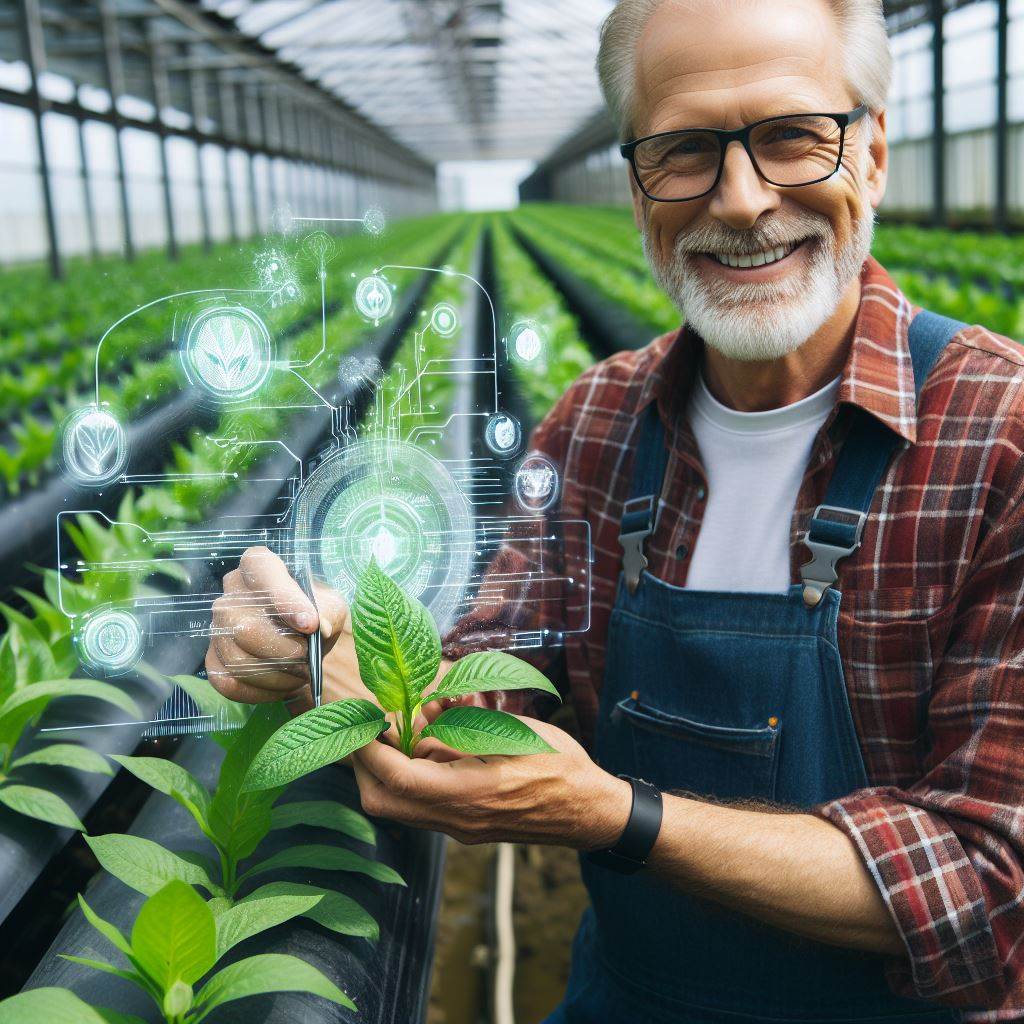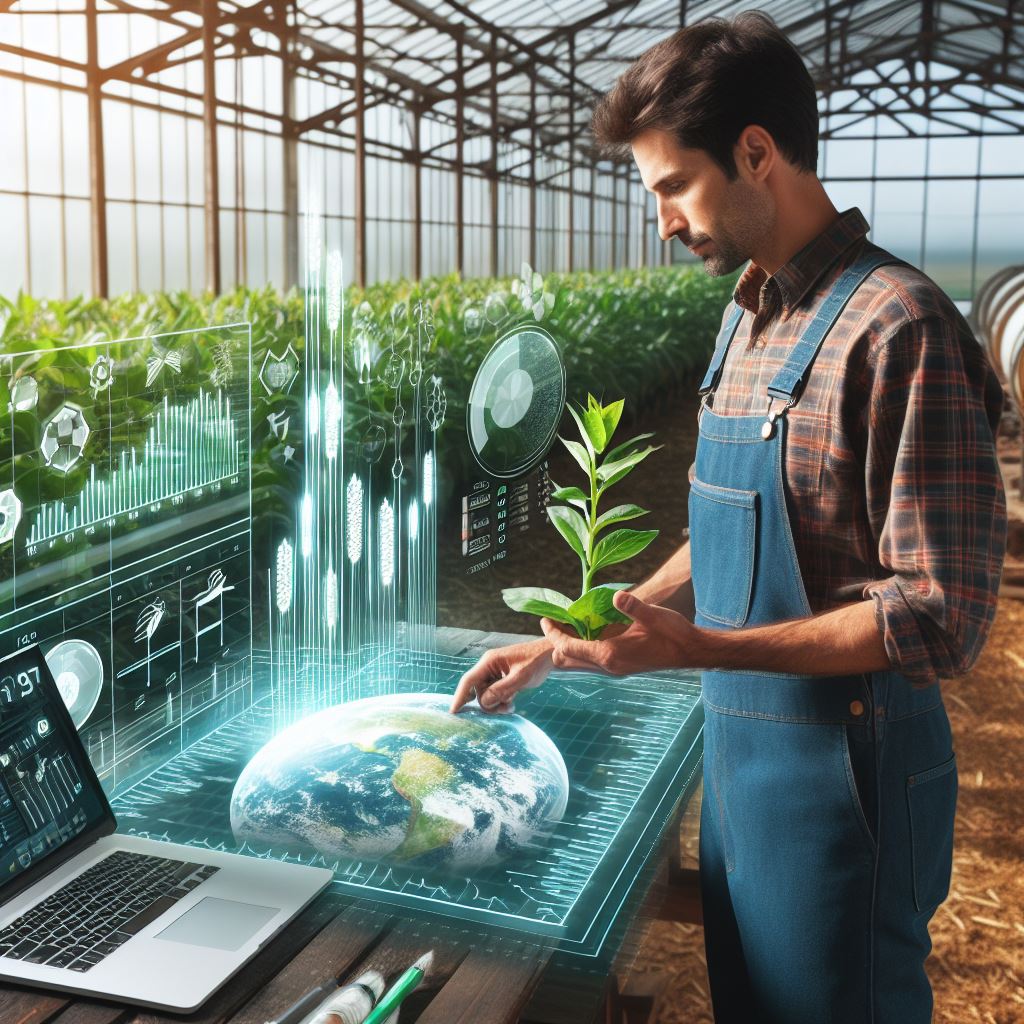Introduction
Agri robots become farmers’ new friends, transforming farming field and enhancing agricultural efficiency with innovative technologies.
A. Importance of agriculture in modern society
Agriculture remains the backbone of human civilization, providing sustenance for our growing population.
Even with advancing technology, farming is labor-intensive, backbreaking work that suffers from a shrinking labor force.
Robots present a promising solution by automating repetitive and strenuous tasks.
B. Agricultural robots and their role
Agbots, or agricultural robots, already populate today’s farms in limited capacities.
However, continued innovation promises a new generation suited to complete end-to-end automation.
The potential benefits include increased crop yields, reduced chemical usage through precision spraying, and preservation of soil integrity via lighter robotic pickers.
Modern agbots still face limitations, including high costs and inability to match human dexterity when handling delicate produce.
Infrastructure and connectivity in rural areas also present adoption challenges.
However, early agbot capabilities and rapid advancement suggest these intelligent tools may soon become commonplace partners for the world’s farmers.
Proponents argue wide-scale agbot adoption represents the only viable path to meet rising food demands while maintaining environmental sustainability and improving labor conditions.
This blog post explores the current state and trajectory of agbot development.
Key topics include evaluating leading agbot prototypes, projecting future capabilities, assessing potential benefits and risks, and analyzing the role governments must play in overseeing this agricultural revolution.
The future of farming appears robotic.
The Evolution of Agriculture
A. Historical overview of traditional farming methods
Agriculture has been practiced for thousands of years using traditional methods such as manual labor and hand tools.
Transform Your Agribusiness
Unlock your farm's potential with expert advice tailored to your needs. Get actionable steps that drive real results.
Get StartedFarmers cleared land and prepared it for cultivation by using simple tools like hoes and spades.
Seeds were sown manually by scattering them across the prepared soil and then covered with a layer of soil.
Watering the crops involved carrying water from nearby sources or using primitive irrigation techniques.
Plants were protected from pests and diseases by manually inspecting and removing them or using natural remedies.
Harvesting was done manually using sickles or scythes, and the grains were separated from the chaff using winnowing techniques.
This traditional farming system required a significant amount of time, effort, and manpower.
The yield was often unpredictable and vulnerable to environmental factors such as weather conditions and pests.
However, it formed the basis of human civilization and sustained communities for centuries.
B. Challenges faced by farmers in the past
Farmers faced numerous challenges in the past, including labor-intensive tasks, unpredictable yields, and dependence on natural factors.
Manual labor was physically demanding and time-consuming, limiting the size of farms and the amount of produce.
Pests and diseases could devastate entire crops, leading to food shortages and economic hardships.
Farmers had to rely on favorable weather conditions for a successful harvest, making agriculture a risky venture.
The lack of advanced machinery and tools made it difficult to increase productivity and meet growing demands.
Transportation and distribution of agricultural products were often hindered by poor infrastructure.
Overall, traditional farming faced various limitations that hindered its efficiency and profitability.
C. Introduction of technological advancements and automation
The introduction of technological advancements and automation revolutionized the agricultural industry.
Mechanized tools and machinery, such as tractors and harvesters, reduced the dependency on manual labor.
Modern irrigation systems, including sprinklers and drip irrigation, improved water efficiency and crop yield.
Genetically modified crops were developed to withstand pests, diseases, and adverse weather conditions.
Precision farming techniques, such as the use of sensors and GPS, helped optimize resource allocation and maximize productivity.
Drones and satellites provided farmers with real-time data on crop health, soil conditions, and pest infestations.
Robots and automation systems are now being deployed in various agricultural tasks, including planting, weeding, and harvesting.
These advancements have led to increased efficiency, higher crop yields, and improved profitability for farmers.
Read: Agri Robots: Revolutionizing Precision Agriculture
Showcase Your Farming Business
Publish your professional farming services profile on our blog for a one-time fee of $200 and reach a dedicated audience of farmers and agribusiness owners.
Publish Your ProfileIntroducing Agri Robots
A. Definition and explanation of agri robots
Agri robots are advanced machines designed to perform various tasks in the agricultural industry.
They leverage innovative technology to automate processes and improve efficiency.
B. Different types of agri robots in use today
- Field robots: Field robots are designed to work in agricultural fields, assisting with tasks such as soil preparation, planting, and monitoring crop growth. They are equipped with sensors to collect data for analysis and optimize farming practices.
- Harvesting robots: Harvesting robots are specifically designed to automate the process of picking fruits, vegetables, and other crops.
These robots are equipped with computer vision systems to identify ripe produce and delicate arms to handle them without damaging them. - Sorting and packing robots: Sorting and packing robots automate the labor-intensive task of sorting and packaging harvested crops.
They use sensors and computer algorithms to ensure accurate sorting based on size, color, ripeness, and quality. These robots increase efficiency and reduce human errors. - Weeding and spraying robots: Weeding and spraying robots utilize advanced algorithms and computer vision to identify and remove weeds from fields.
These robots minimize the use of harmful herbicides by precisely targeting weeds, ensuring healthier crops and reducing environmental impact.
C. Benefits of Agri robots
Agri robots have revolutionized the agricultural industry by improving productivity, reducing labor costs, and promoting sustainable practices.
They offer several benefits:
- Higher efficiency: Agri robots can work around the clock without tiring, resulting in increased productivity and faster completion of tasks.
- Cost savings: By replacing manual labor, agri robots help reduce labor costs, which can be a significant expense for farmers.
- Precision agriculture: With their advanced sensors and data collection capabilities, agri robots allow farmers to precisely monitor crop health, soil conditions, and water usage. This data helps optimize farming practices and maximize yields.
- Environmental sustainability: Agri robots enable precise application of fertilizers, herbicides, and pesticides, minimizing the negative impact on the environment.
They also reduce soil erosion and conserve water resources through efficient irrigation techniques.
Essentially, agri robots have become valuable allies in modern agriculture.
They perform a wide range of tasks, including field preparation, planting, harvesting, sorting, packing, weeding, and spraying.
With their efficiency, precision, and sustainability, they are transforming the way crops are grown, leading to increased productivity and reduced environmental impact.
As technology continues to advance, agri robots will play an even more significant role in ensuring food security and promoting sustainable farming practices.
Read: Robotics in Farming: A 2024 Guide
Benefits of Agri Robots
A. Increased efficiency and productivity on the farm
- Agri robots are designed to perform tasks at a much faster rate than human workers.
- They can work continuously without the need for breaks or rest, resulting in increased productivity.
- Robots can operate 24/7, ensuring that tasks are completed in a timely manner.
- By automating repetitive tasks, agri robots free up human workers to focus on more complex and strategic activities.
- This leads to improved efficiency in overall farm operations.
B. Reduction in labor costs and reliance on human workers
- Using agri robots can significantly reduce labor costs for farmers.
- With the increasing shortage of agricultural labor, robots offer a reliable alternative.
- Robots do not require wages, benefits, or accommodations, making them cost-effective in the long run.
- Farmers can reduce their dependence on human workers, especially during peak seasons or labor shortages.
C. Precision farming and optimized resource utilization
- Agri robots enable precision farming by performing tasks with high accuracy and consistency.
- They can precisely apply fertilizers, pesticides, and herbicides, minimizing wastage and environmental impact.
- Robots equipped with sensors can collect real-time data on crop health, soil moisture, and nutrient levels.
- This data helps farmers make data-driven decisions, leading to optimized resource utilization.
- By using the right amount of resources at the right time and place, farmers can maximize crop yield.
D. Minimized environmental impact through targeted applications
- Agri robots offer targeted applications of inputs, minimizing their impact on the environment.
- They can precisely target weeds, pests, and diseases, reducing the need for blanket applications of chemicals.
- With their precision, robots can avoid the overuse of resources, preventing soil and water pollution.
- By reducing chemical usage, agri robots contribute to a more sustainable and eco-friendly farming system.
- This ultimately leads to healthier soils, cleaner water sources, and improved biodiversity in the agricultural ecosystem.
In general, agri robots bring numerous benefits to the farming industry.
Their ability to increase efficiency and productivity, reduce labor costs, enable precision farming, and minimize environmental impact make them valuable assets on the field.
By embracing agri robots, farmers can propel their operations forward while ensuring sustainable and responsible farming practices for the future.
Read: Agri Robots: The Future of Farming Now

Case Studies
A. Large-scale crop farming
Agri robots have revolutionized large-scale crop farming by increasing efficiency and reducing the need for manual labor.
These robots can autonomously plant seeds, apply fertilizers and pesticides, and harvest crops.
They use advanced sensors and AI algorithms to accurately identify plants, weeds, and soil conditions.
By automating these tasks, agri robots save time and resources, resulting in higher yields and lower costs for farmers.
B. Livestock management
Agri robots have also found success in livestock management.
They assist farmers in monitoring and caring for their animals, ensuring their health and well-being.
For example, robotic milkers have been developed that can automatically milk cows, reducing the physical strain on farmers and improving milk production.
These robots can monitor the milk quality and detect any signs of illness or disease in the animals.
They provide valuable data to farmers, allowing them to make informed decisions for their livestock.
C. Greenhouse and hydroponic cultivation
In greenhouse and hydroponic cultivation, agri robots are used to automate tasks such as seeding, watering, and monitoring environmental conditions.
These robots are equipped with precision sensors that can accurately regulate temperature, humidity, and nutrient levels.
They ensure optimal growing conditions for plants, maximizing yields and minimizing resource wastage.
Agri robots also reduce the risk of contamination and disease transmission in these controlled environments.
D. Orchards and vineyards
Agri robots have proved to be valuable helpers in orchards and vineyards.
They can efficiently prune trees, monitor fruit ripeness, and even perform selective harvesting.
These robots use image recognition technology to identify ripe fruits and delicate robotic arms to gently pick them.
By automating these labor-intensive tasks, farmers can save time and ensure consistent quality in their produce.
Agri robots also help reduce the reliance on seasonal labor, which can be challenging to find at the right time.
These case studies highlight the diverse applications and benefits of agri robots in various agricultural sectors.
They have proven to be effective in increasing productivity, reducing costs, and improving the overall efficiency of farming operations.
As technology continues to advance, we can expect agri robots to play an even more significant role in the future of agriculture.
Read: Tech Trends: Agri Robotics in 2024
Implications and Challenges
A. Potential impact of agri robots on job opportunities in agriculture
Agri robots have the potential to automate repetitive tasks in agriculture, reducing the need for manual labor.
This advancement may lead to job loss in certain areas of farming, particularly in tasks that can be easily automated.
However, it is important to note that agri robots can also create new job opportunities in fields such as robotics engineering and maintenance.
Furthermore, the increased efficiency brought by these robots can enhance productivity and enable farmers to focus on more complex and creative tasks.
B. Ethical considerations related to automation in farming
The implementation of agri robots raises ethical questions regarding the well-being of animals that humans typically handle during farming activities.
Showcase Your Farming Business
Publish your professional farming services profile on our blog for a one-time fee of $200 and reach a dedicated audience of farmers and agribusiness owners.
Publish Your ProfileIt is crucial to assess whether the use of robots might compromise animal welfare and develop proper regulations to address this concern.
Additionally, the potential displacement of human workers should be ethically managed to ensure fair transition and support retraining initiatives.
On the positive side, if used responsibly, agri robots can reduce the use of harmful chemicals and pesticides, promoting more sustainable farming practices.
C. Technological and infrastructure requirements for widespread adoption
The widespread adoption of agri robots requires advancements in robotics technology, including sensor capabilities, navigation systems, and AI algorithms.
Moreover, there is a need for suitable infrastructure, such as high-speed internet connectivity and reliable power supply, to support the operation of agri robots.
Farmers and agricultural communities must have access to the necessary resources and support systems to integrate agri robots into their farming operations.
Investments in research and development, as well as collaborations between technology providers and agriculture stakeholders, are essential to overcome these challenges.
D. Economic feasibility and accessibility of agri robots for small-scale farmers
One significant challenge is ensuring the economic feasibility of agri robots, especially for small-scale farmers with limited financial resources.
The initial investment cost, maintenance, and operational expenses of robots may be too high for these farmers to afford.
Government incentives and subsidies can play a crucial role in making agri robots more accessible, enabling small-scale farmers to benefit from their advantages.
In addition, the development of scalable and modular robot systems can provide cost-effective options for farmers, allowing them to tailor the technology to their specific needs.
In essence, the implications of agri robots extend to various aspects, including job opportunities, ethics, technology, and economics.
While there may be concerns regarding job displacement and ethical considerations, agri robots present possibilities for new employment opportunities and sustainable farming practices.
Overcoming challenges related to technology, infrastructure, and affordability is key to ensuring widespread adoption and maximizing the benefits of agri robots for farmers of all scales.
The Future of Agri Robots
A. Current trends and developments in agri robot technology
- The agriculture industry is rapidly adopting agri robots to enhance productivity and reduce labor costs.
- Robots equipped with sensors and cameras can accurately detect crop health and suggest precise interventions.
- Autonomous robots equipped with AI algorithms can analyze data to optimize irrigation, fertilization, and pest control.
- Drone technology is being extensively used for aerial monitoring of crops, identifying diseased plants, and spraying pesticides.
- Robotics companies are continuously improving the durability and adaptability of agri robots to handle various terrains and weather conditions.
- The use of robotic exoskeletons is revolutionizing the labor-intensive tasks in agriculture, reducing fatigue and preventing injuries.
- Agri robots are also being employed for harvesting fruits and vegetables, increasing efficiency and reducing post-harvest losses.
B. Predictions for the future of farming and the role of robots
- The future of farming will heavily rely on agri robots to meet the increasing global food demand.
- As population growth continues, conventional farming methods will become unsustainable, and robots will play a crucial role in addressing this challenge.
- Farmers will benefit from increased accuracy and efficiency in cultivation, resulting in higher yields and reduced resource waste.
- Agri robots will enable farmers to transition towards more sustainable practices, such as precision agriculture and organic farming.
- With advancements in technology, robots will be capable of performing complex tasks like genetically modifying crops and producing crops independent of climate conditions.
- The role of robots in data collection and analysis will become essential for making informed decisions and optimizing farming practices.
- Collaboration between agri robots and farmers will become seamless, with robots becoming indispensable partners in farm management.
C. The potential for integration with other emerging technologies, such as AI and blockchain
- Integration of AI with agri robots will enable them to enhance their decision-making capabilities and adapt to changing conditions.
- AI algorithms will help agri robots recognize patterns, improve crop prediction models, and optimize resource allocation.
- Blockchain technology can ensure the traceability and transparency of agricultural processes, from seed to consumer.
- Agri robots can record data on crop origin, cultivation practices, and chemical inputs to establish immutable records on the blockchain.
- Consumer demands for sustainable and ethically-produced food can be met by verifying the authenticity and quality of agricultural products through blockchain.
- AI-powered robots can assist in supply chain management by monitoring inventory, predicting demand, and optimizing logistics.
- Integration of agri robots, AI, and blockchain will create a comprehensive ecosystem that revolutionizes the agriculture industry.
In a nutshell, the future of farming looks promising with the rapid advancements in agri robot technology.
Current developments indicate increased efficiency, productivity, and sustainability in agriculture.
With integration of AI and blockchain, agri robots will become indispensable tools for farmers, enabling them to tackle future challenges effortlessly.
The transformation brought about by agri robots will not only ensure food security but also promote responsible and transparent agricultural practices.
Conclusion
A. Recap of the benefits and challenges of agri robots
Agri robots have shown immense potential in revolutionizing the field of agriculture.
They offer various benefits such as increased efficiency, reduced labor costs, and improved crop yield.
However, there are also significant challenges to overcome, including high upfront costs and technical limitations.
B. Encouragement for readers to explore and stay updated on the latest advancements in the field
As technology continues to advance at a rapid pace, it is crucial for farmers and enthusiasts alike to stay updated on the latest advancements in agri robots.
By exploring and adapting to new technologies, individuals can gain a competitive edge and improve their agricultural practices.
C. Final thoughts on the transformative potential of agri robots in modern agriculture
Agri robots have the potential to transform modern agriculture by revolutionizing traditional farming practices.
With their ability to automate various tasks, monitor crop health, and optimize resource usage, they can significantly improve productivity and sustainability in the agricultural industry.
It is important to recognize and embrace the transformative potential of agri robots, as they offer a promising solution to the challenges faced by farmers in meeting the increasing global demand for food while minimizing environmental impact.
By embracing agri robots and staying updated on advancements, we can build a future where farming is more efficient, productive, and sustainable.




